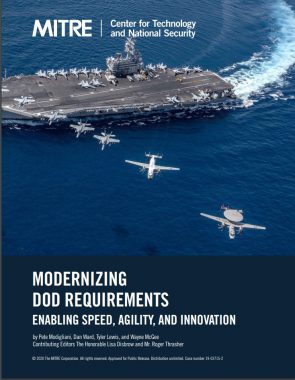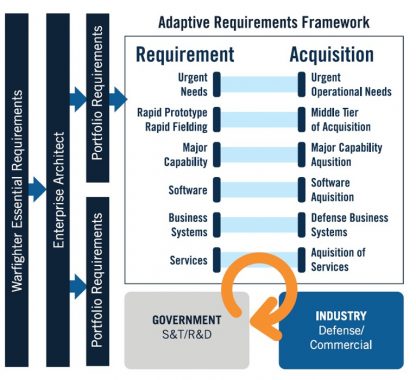Disrupting Acquisition Blog
Modernizing DoD’s Requirements System
The world is accelerating into the future, but the DoD’s requirements system is stuck in the past. The current approach to generating requirements is too slow to produce results when they matter most, too inflexible to account for an unpredictable environment, and too narrowly focused to satisfy joint warfighting needs across all domain operations.
Gen Hyten, Vice Chairman of the Joint Chiefs, has long been a vocal critic of JCIDS, criticizing the time it takes to define and approve requirements and focusing too much on systems vice capabilities. In January, Gen Hyten spoke at CSIS on a variety of topics including modernizing JCIDS.
 We share Gen Hyten’s views about the need for a modern JCIDS environment that can rapidly exploit leading technologies for military advantage. My colleagues Dan Ward, Tyler Lewis, Wayne McGee, and I co-authored a paper for MITRE’s Center for Technology and National Security titled: Modernizing DoD’s Requirements System: Enabling Speed, Agility, and Innovation. This paper proposes a three-pronged approach to reforming the requirements process. First, the DoD should refine what it means by “requirements.” Defining enduring, enterprise-level requirements within major mission areas allows for management at the portfolio level, improving alignment across systems and enabling more flexibility and innovation at lower levels. Next, the DoD should establish an Adaptive Requirements Framework that parallels the new Adaptive Acquisition Framework and provides new pathways for generating and validating requirements. Finally, the DoD should rethink how programs progress through each of the new pathways.
We share Gen Hyten’s views about the need for a modern JCIDS environment that can rapidly exploit leading technologies for military advantage. My colleagues Dan Ward, Tyler Lewis, Wayne McGee, and I co-authored a paper for MITRE’s Center for Technology and National Security titled: Modernizing DoD’s Requirements System: Enabling Speed, Agility, and Innovation. This paper proposes a three-pronged approach to reforming the requirements process. First, the DoD should refine what it means by “requirements.” Defining enduring, enterprise-level requirements within major mission areas allows for management at the portfolio level, improving alignment across systems and enabling more flexibility and innovation at lower levels. Next, the DoD should establish an Adaptive Requirements Framework that parallels the new Adaptive Acquisition Framework and provides new pathways for generating and validating requirements. Finally, the DoD should rethink how programs progress through each of the new pathways.
 Recommendations to Modernize DoD’s Requirements System
Recommendations to Modernize DoD’s Requirements System
1. Organize and empower for change. Ensure that requirements team members are passionate about reform and represent a diverse spectrum of experience and roles, including experts in organizational transformation. Give the team broad direction, clear priorities, and aggressive timelines.
2. Experiment and learn. Start with the Adaptive Requirements Framework. Then, adopt WER. Select one portfolio from each service and the 4th Estate to develop a set of overarching, enduring requirements and performance measures. Allow these pilot acquisition portfolios greater flexibility to achieve portfolio objectives by shaping program requirements.
3. Revisit boards and documents. Review the structure, membership, and alignment of the joint and service boards. Start with a clean sheet for new and legacy requirements documents.
4. Codify decisions and make information accessible. Using the Adaptive Acquisition Framework as the guiding structure, collaboratively rewrite the extensive CJCSI 5123.01H and JCIDS Manual from a clean sheet. Provide simple, clear policy direction in the CJCSI with supporting guidance in the manual.
5. Address the human element. Develop a strategy for a more formalized Requirements Management profession. Ensure this strategy includes the billets; education, training, and certification; targeted recruiting; career paths; and engagements with the R&D community, industry, and innovation organizations across the defense community.
6. Spread the word. To effectively implement the new processes, provide roadshow briefings, workshops, and just-in-time training for the key roles and teams.
What do you think of this vision? What would you add or change as recommendations to modernize DoD’s requirements system? Where would you start in implementing a new model?
Disclaimer: The opinions expressed here are those of the authors only and do not represent the positions of the MITRE Corporation or its sponsors.
Subscribe to Our Newsletter


0 Comments